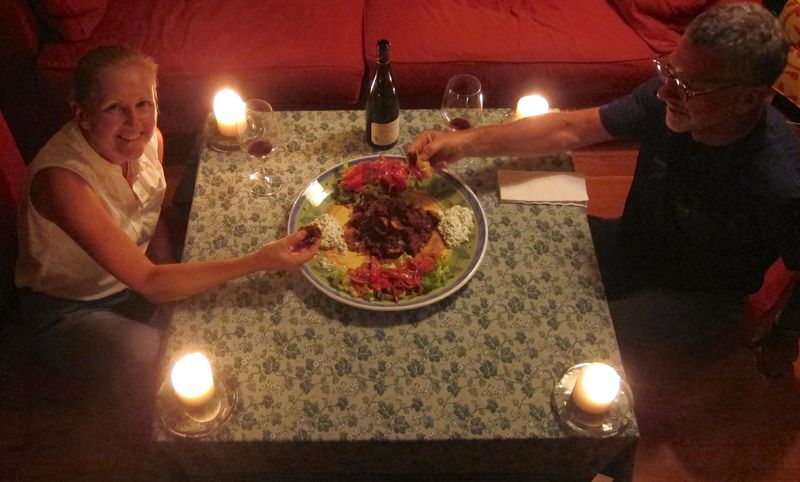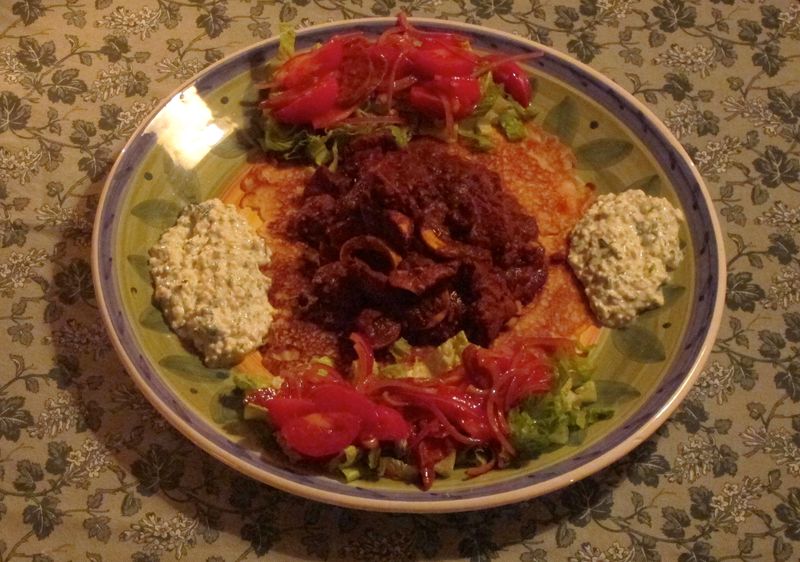Ethiopian cuisine is known for spicy vegetable and meat dishes, usually in the form of wat (or wot), a thick stew, served atop injera, a large sourdough flatbread, which is about 50 centimeters in diameter and made out of fermented teff flour. Ethiopians eat with their right hands, using pieces of injera to pick up bites of entrées and side dishes. Utensils are rarely used with Ethiopian cuisine.
You will see from the photo that for the sake of authenticity, Josée and I followed the Ethiopian etiquette of eating with the right hand. Unfortunately, this did not serve the intended purpose as half way though the meal, we both admitted to each other that we are right handed for those other functions of, you know, personal hygiene.
Ethiopian cuisine mostly consists of breads, stews (wat), grains, and spices. Typically, an Ethiopian meal includes a combination of injera (flatbread) with different wats, yet each cultural group has their unique variation. A typical snack would be small pieces of baked bread called dabo kollo or local grains called kollo. Pasta is frequently available throughout Ethiopia, including rural areas. Coffee is also a large part of Ethiopian culture/cuisine; after every meal a coffee ceremony is enacted and espresso coffee is drunk. The pasta and the espresso are no doubt holdovers from the Italian occupation of 1936 - 1941.
Berbere, a combination of powdered chili pepper and other spices (somewhat analogous to Southwestern American chili powder), is an important ingredient used in many dishes. Also essential is niter kibbeh, a clarified butter infused with ginger, garlic, and several spices.
Our Ethiopian dinner:
Doro Wat
Iab
Queen of Sheba salad
Injera
Doro Wat: Chicken stew made with beri-beri or berbere. Beri-beri is made with tomato paste, paprika,, red wine ginger, red pepper flakes, cardamon, nutmeg, cloves, cinnamon and allspice. Turmeric is also added at the end.
Injera: Josée made hers with whole wheat flour as teff flour cannot be found here in Bermuda. Wheat flour and buttermilk is also used.
Iab: White curd cheese. Since authentic Iab could not be found, a mixture of cottage cheese and yogurt with lemon zest and parsley was substituted, a close approximation.
Queen of Sheba salad: Tomatoes, onions, hot peppers and lettuce with a dressing of tomato sauce, vinegar, oil, wine and hot pepper sauce.

The wine was not Ethiopian, obviously.
You know what? I think we'll miss this when it's all over.
Cheers,
Joseph Froncioni









































































































![Jeremy Scahill: Blackwater: The Rise of the World's Most Powerful Mercenary Army [Revised and Updated]](../../../6a00d8341c075e53ef0128756487fa970c-75hi.jpg)


Am immensely enjoying your blog...Interesting, eloquent, MOUTH WATERING, but most of all fun to read!! Feel like I'm watching Julie and Julia! CANNOT WAIT to join you for Moroco & Tunisia dinner on saturday! Although after reading about last night's dinner, I hope you've washed your right hand before preparing!!!
Angela Marini
Posted by: Angela Marini | November 20, 2012 at 05:52 PM